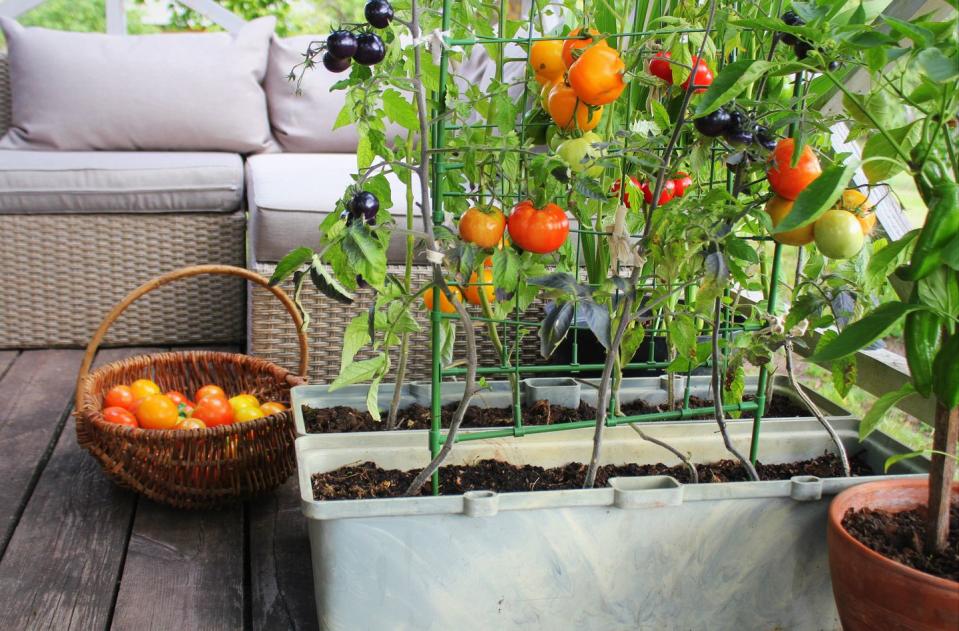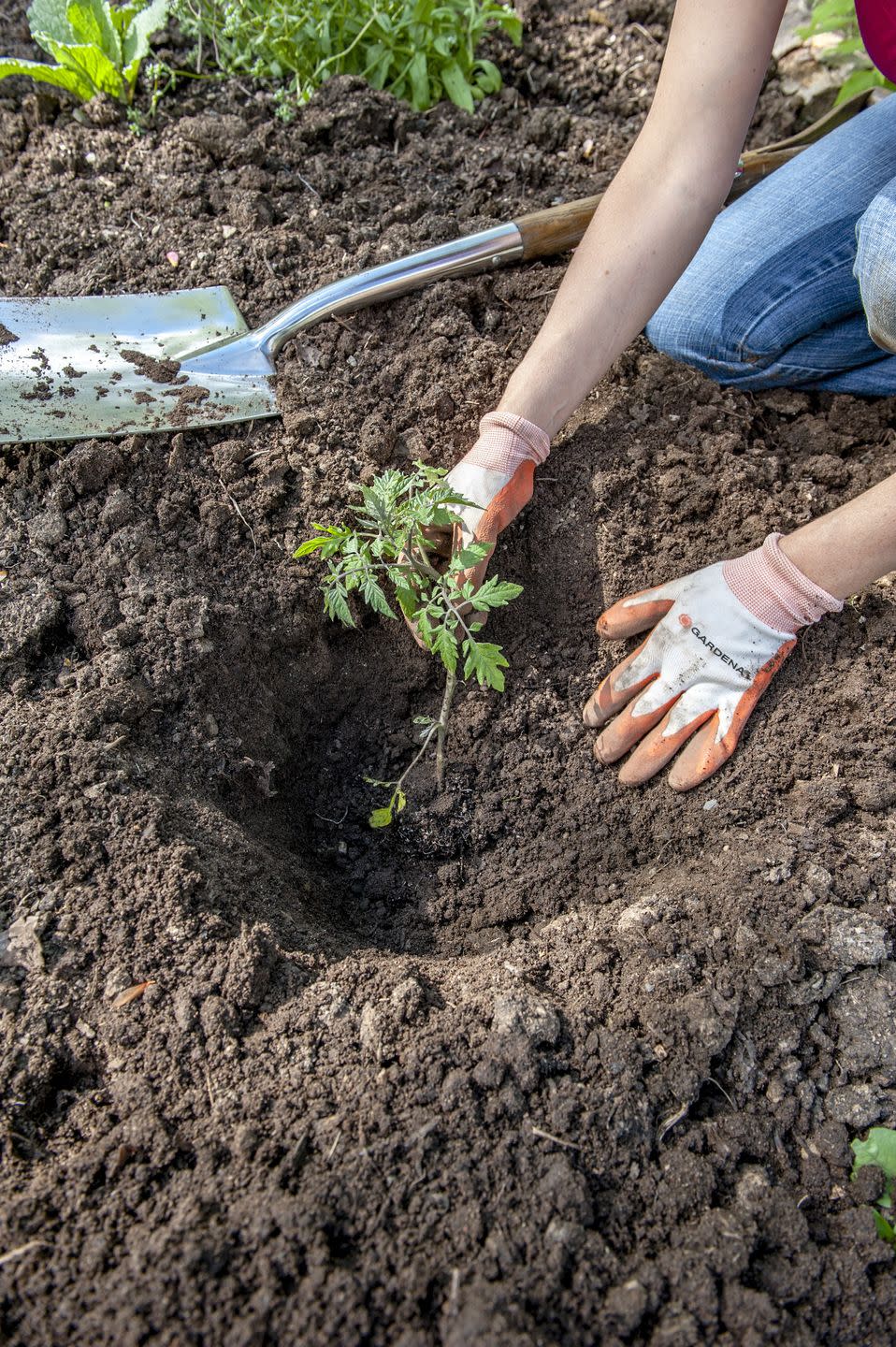Learn How to Grow Your Own Tomatoes in Your Backyard

"Hearst Magazines and Yahoo may earn commission or revenue on some items through these links."
It doesn't matter if you're a city dweller with a tiny balcony or a rancher with a huge country backyard—anyone can learn how to grow tomatoes with the right gardening tools and conditions. There are over 10,000 varieties of tomatoes, and you’ll never be able to go back to store-bought once you've had a juicy, flavorful bite of one harvested from your own vine. Now that's what a real tomato tastes like! “They’re the perfect crop because they have an amazing diversity of shapes, sizes, colors, and flavors,” says Craig LeHoullier, author of Epic Tomatoes: How to Select & Grow the Best Varieties of All Time. “They have dominant flavors and a host of nuances.”
As you think about which variety to buy, one of the first things to understand is "growth habit," so you can know if you have the space for the particular type. That’s just a fancy way of saying whether the tomato you're looking to plant is a type that will develop into a long, sprawling vine or if it’ll stay more compact. Read the plant tag or description to figure out what growing conditions are needed. Indeterminate types keep growing and producing until a frost, so they can reach 10 feet or more; they will need staking to support them! Determinate types have fruit that generally ripens in a narrow time frame and top out at three to four feet tall. Dwarf types stay nice and compact, so they’re a good choice for containers.
Now that you have the different types of tomatoes down, read on for everything you need to know about how to grow your own tomatoes. And don't forget a pair of hardy gardening gloves!

What month do you plant tomatoes?
The proper month to plant tomatoes depends on your climate and location! Tomatoes are warm-weather plants that need a lot of sunlight, so they should go into the ground or pots after the danger of frost has passed. There's truly no trying to rush it because a frost will kill them. In the US, the last frost date is drastically different depending on the region, ranging from late February to early May. Check with your local university coop extension service (find yours here) to learn the estimated last frost date in your area.
If you decide to start your tomatoes from seed, sow them in indoor nurseries approximately six weeks before the last frost. You can then plant them about two weeks after the last frost or when day and night temperatures remain in the mid-50s. You can also direct-seed your tomatoes in garden soil, but be sure that the soil temperature is at least 55°F (70°F soil is optimum). The soil temperature should be at least 60°F if you decide to transplant seedlings. Tomatoes can take anywhere from 60 days to over 100 days to harvest, so you also don't want to plant them too late and have the harvest cut off by the first frost of fall.
Where should I plant tomatoes?
As mentioned, tomatoes are heat-lovers. “They need full sun, which means about six or more hours per day, though you can get away with two to four hours if you’re growing smaller types such as cherry tomatoes,” says LeHoullier. Watch your yard at different times including morning, lunchtime, mid-afternoon, and early evening to see how many hours of sun an area receives.
How can I grow tomatoes in pots?
If you don’t have a sunny spot in your yard (or you don’t have a yard!), plant in containers and move them to wherever the sun does shine. When selecting a container, make sure it has drainage holes, or drill some yourself. An indeterminate type needs a container with a 10-gallon capacity, or 24-inch tall and wide pots. Determinate and dwarf do well in 5-gallon, or 12-inch tall and wide pots. Containers also are a way to get around poor soils in your yard such as heavy clay or sand.

What kind of tomato plants should I buy?
When you’re at the nursery, don’t automatically buy the tallest plants. Look for overall health: They should be a deep green, not wilted, and have no yellow or brown spots or brown edges on leaves, which indicates disease, says LeHoullier.
What should I do before planting tomatoes?
If your plants have been in the greenhouse, you’ll need to go through the process of “hardening off” to make them more resilient before they’re planted. Put them outside in a shady area for an hour or two the first day, then two to three hours the second day, and so on. Increase the time and sunlight they’re receiving over the course of a week. “It’s an important step because they’re not used to wind, rain, and sun and can be sunburned or the stems can snap off if you expose them to the elements immediately,” says LeHoullier. Seedlings that have already been outdoors can be planted right away.

How should I plant tomatoes?
It may seem counterintuitive, but bury about two-thirds of your tomato’s stem in a deep hole. If you have heavy soil and it’s hard to dig deep, dig a trench and lay the plant down sideways so that the top sticks out. It seems odd but it works: The plant will develop roots all along the buried stem—more roots means a stronger plant!
Situate your plants about three feet apart on all sides. “Tomatoes need air to circulate around them to reduce the risk of disease,” says LeHoullier. Indeterminate and some determinate types will need a stake placed a few inches from the stem for support. Tie up the plant loosely with twine every 6 to 12 inches as it grows.
How can I take care of my tomato plants?
If you’re planting in-ground, add a paper cup collar or loose-fitting tin foil around the plant base (with some above the soil and some below) to keep away cutworms (a springtime pest that can sever the stem at the soil line). Mulch with untreated grass clippings, shredded bulk mulch, or landscape fabric a few inches away from the stem to help keep soil-borne pathogens from splashing up on your plant when watering. Let your plant settle in for a week, then feed with a balanced fertilizer, following the directions on the package.

How should I water tomato plants?
Water at the base of the plant. A soaker hose is great, but a good, old-fashioned hose or watering can works too. Avoid using overhead sprinklers which promote disease development. Water consistently: A stressed plant will be more vulnerable to disease, says LeHoullier. Container plants need to be checked daily because they’ll dry out more quickly than those in the ground. And if you’re the forgetful type, self-watering containers, which have a reservoir and wicking system to keep the soil moist, are a convenient option.
How often should I check on my tomatoes?
Check out your plants every day or so to stay on top of potential pests or diseases. It’s also smart to keep a sort of informal journal about what you planted and when, as well as what you’re seeing in your garden, says LeHoullier. Take a few photos or video to jog your memory next spring. It will remind you what worked (or didn’t!). After all, experience is a great teacher, and growing tomatoes is as much about the journey as the destination!
You Might Also Like

